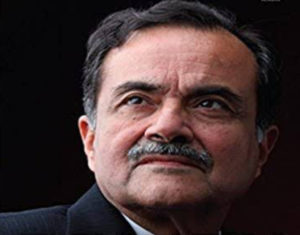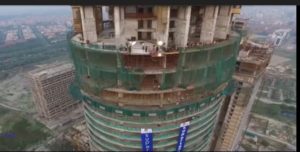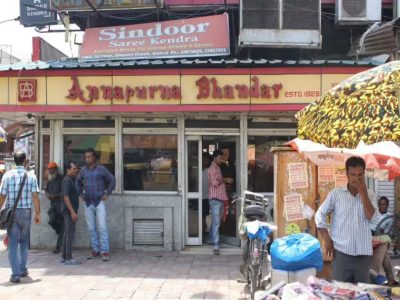Sanjay Gandhi was the political force behind the creation of Noida 45 years ago. Jagdish Khattar, the man assigned to do the job—gives a detailed account of how he did that…
On the 17, Noida completed 45 years of its existence. It was created in a hurry, during the emergency, on the personal initiative of Sanjay Gandhi, who wanted to shift 60,000 small industrial units out of the capital across the Yamuna. And when he made up his mind, there was no looking back. Things were made possible at an express pace—within a week.
One of the persons at the core of the creation of Noida is Jagdish Khattar, who was the first CEO of Noida. In 1975, he was the managing director of UP state Industrial Development Corporation (UPSIDC) with head office located in Kanpur. “Noida was established as an industrial area,” he remembers, and the first ten sectors created in his tenure were industrial. “Noida is one of the best planned cities of India and that was possible because from the very beginning acquiring the land, developing the infrastructure like roads, electricity, etc., was done by the government,” explains Khattar.
Only after the development of the civic infrastructure was the land transferred to private parties unlike Gurugram that was developed by private players, “that explains the wide roads and planned growth of Noida,” he asserts. Now, after four decades, along with Noida, its sister city Greater Noida is known for its developed growth, following the model of Noida.
Jagdish Khattar narrates in detail how the whole process of establishing Noida was “illegal”. His noting in the government files says so. He was overruled and entrusted with the task of creating Noida by the government. “I was just executing a government project,” he says.
The emergency had been imposed six months ago and on a Tuesday morning of December 1975, N D Tiwari, the then chief minister of Uttar Pradesh (UP) was summoned to Akbar Road by Sanjay Gandhi. Tiwari was accompanied by two bureaucrats, one of them was the resident commissioner of UP posted in Delhi, while the other was Khattar. At that time, Khattar was also overseeing the establishment of industrial areas in Amethi and Raebareli—the constituency of Sanjay and his mother Prime Minister Indira Gandhi, respectively. His plate was full.
Sanjay Gandhi was sitting with a Delhi map and wanted the chief minister to locate a place across the river Yamuna, east of Delhi, where all the pollution-causing industries—small and medium—could be relocated at the earliest possible. He urgently felt that Delhi needs a facelift. They were given three days to find a suitable place and be ready with a concrete proposal on Friday.

“That year December was far colder,” recollects Khattar, “the villagers were sitting wrapped in blankets when we went to find a suitable location.” In two days, Sanjay Gandhi arrived in his old matador, accompanied by Jagmohan—was the vice-chairman of the Delhi Development Authority. Sanjay was shown the possible options, he selected a patch of land where Noida was founded. He insisted that the work for an industrial area should start on Monday—in two days.
Khattar at an opportune moment informed the chief minister Tiwari “in whispers” that time is “too short”, the land has not been acquired and belongs to the farmers. Starting any work at this time would be “illegal”. Sanjay Gandhi overheard the whispers and asked if there’s a problem. Tiwari assured that on Monday bulldozers will arrive and the work shall commence. The work started as per plan. As they say, the rest is history.
These were the days when the fastest mode of communication was trunk call, and it was not humanly possible to manage on a day-to-day basis various projects across the state of UP. Khattar suggested the creation of a local agency that would monitor work on the ground. “It was not easy to manage,” says Khattar. He was posted in Kanpur and was overseeing the work in Amethi and Raebareli. Noida is very far off. He went to his bosses in Lucknow—P N Dhar was his secretary—to explain, “It’s very difficult.” Khattar was told by his bosses, “You’re chickening out. You have to do it.”
There were glitches, the red tape, the rule of the land, and the finances. But Sanjay Gandhi had made up his mind. He would visit the site on a weekly basis to monitor progress and send his feedback to the chief minister Tiwari—he wasn’t happy with the tardy pace.
“They (read Tiwari) got some firing (from Sanjay Gandhi),” remembers Khattar—now 80 years old and a resident of Noida. The government of UP, gave in to Khattar’s demand, decided to form a separate agency—an authority—that was to expeditiously carry out development work. Noida was established as an agency under UPSIDC, Khattar was assigned the supervisory role while a local officer—deputy CEO—was to oversee day-to-day work.
A committee was created, including a sitting judge, to formulate the rules that will govern the functioning of the authority–New Okhla Industrial Development Authority–and NOIDA is its acronym. Since the authority had so much to accomplish in so little a time, Khattar made sure it had the autonomy to acquire land, and also ensured financial autonomy from the government. He sought the creation of a corpus—or seed money or the kitty—to buy land and expedite the development work.
When the proposal reached the finance department of UP, a red flag was raised. The government was hesitant to award financial autonomy to Noida. “There was a big debate on speedy implementation of projects without having to delegate financial powers when the phone rang,” narrates Khattar. After Sanjay Gandhi’s phone call the approval was done in “two minutes,” laughs Khattar. “To the best of my knowledge, no other authority in the country that’s owned by the government, other than Noida (later Greater Noida) has this kind of functional autonomy,” he asserts.

After the emergency, when the Janata Party government came into power, an inquiry was ordered into the making of Noida. The court summons were issued against Sanjay Gandhi and N D Tiwari amongst others, also included the then district magistrate of B N Tiwari and Jagdish Khattar. The officers weren’t spared but Khattar was saved because he had noted categorically in the file “this is an illegal work.” He was overruled by the political bosses. He was posted for two years in Noida before he left for the UK on another assignment.
The initial plan, as he had envisioned, was that Noida would exclusively be an industrial area. Noida being close to Delhi, bureaucrats and politicians, also various Public sector enterprises, sought the development of residential sectors. He was also offered to buy a plot of land at throw-away prices in sectors 14 and 15 A, which is now the poshest part of Noida where top babu and neta reside.
Khattar didn’t want to indulge in anything hanky-panky and lose “my peace of mind.” He already had brought a plot of land in Ghaziabad on a government loan, and as per rules, was barred from buying a second property in the same district. He adhered to the rule book. “I never got a flat or a land allotted to me,” he says. Later, he sold his Ghaziabad property “to buy from the market” a house in Sector 40 where he currently resides.
Khattar also served as the managing director of Maruti Udyog—the small car for Indians—was also a realization of one of Sanjay Gandhi’s visions. Leading a retired life, Khattar takes up odd projects to keep himself busy, and is considered one of the finest IAS officers who accomplished so much in his career.





